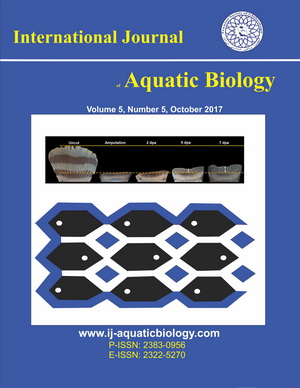Do lunar cycles affect molting of mud crabs Scylla olivacea reared in a closed recirculation system?
Downloads
Mud crabs grow through molting, a process during which they become highly vulnerable to predation. This makes molting management crucial in crab aquaculture, including practices utilizing crab boxes. Environmental factors such as lunar cycles influence molting in natural habitats. However, research is limited to molting in controlled environments with closed recirculation systems that offer environmental stability, water resource efficiency, and precise feed management. This study investigated the effects of the lunar phase on the molting stages of mud crabs reared in a closed recirculation system. A total of 40 Scylla olivacea specimens were reared for three months to observe molting patterns across eight lunar phases: new moon (NM), waxing crescent (WXC), first quarter (FQ), waxing gibbous (WXG), full moon (FM), waning gibbous (WG), last quarter (LQ), and waning crescent (WNC). Overall, 77.5% of crabs were molted during the study period. No molting occurred during the WXC, WXG, WNC, and WG phases. Molting prevalence was higher during FM (22.5±2.5%) and NM (20±2.9%) phases compared to FQ (17.5±1.4%) and LQ (17.5±1.4%). Post-molting weight gain was 31.7±5.9 (NM), 32.2±4.4 (FQ), 31.2±5.9 (FM), and 27±3.2 (LQ), while carapace width (CW) increased by 9.0±1.6 (NM), 8.5±1.3 (FQ), 9.5±2.4 (FM), and 8.2±1.77 mm (LQ), respectively. The results showed molting frequency and growth did not differ significantly between lunar phases NM, FQ, FM and LQ. In closed recirculation aquaculture systems where natural fluctuations such as tidal changes were eliminated, molting remained associated with the lunar cycle, suggesting the persistence of instincts and circadian rhythms in mud crabs in controlled environments. This study provides valuable insights for mud crab farmers, particularly for optimizing productivity by understanding the influence of lunar phases on molting in closed recirculation systems.
Downloads
Achdiat M., Tan K., Fujaya Y., Wang Y., Martin M., Shu-Chien A., Fazhan H., Waiho K. (2024). A comparative study on the antennae morphology and ultrastructure of three mud crab species of the genus Scylla from Setiu Wetlands, Terengganu, Malaysia. Microscopy Research and Technique, 87(7): 1443-1452.
Chabot C., Ramberg-Pihl N., Watson W. (2016). Circalunidian clocks control tidal rhythms of locomotion in the American horseshoe crab, Limulus polyphemus. Marine and Freshwater Behaviour and Physiology, 49(2): 75-91.
Chen S., Shi C., Migaud H., Song C., Mu C., Ye Y., Wang C., Ren Z. (2022). Light spectrum impacts on growth, molting, and oxidative stress response of the mud crab Scylla paramamosain. Frontiers in Marine Science, 9: 840353.
DeVries M.C., Epifanio C.E., Dittel A.I. (1983). Lunar rhythms in the egg hatching of the subtidal crustacean: Callinectes arcuatus Ordway (Decapoda: Brachyura). Estuarine, Coastal and Shelf Science, 17(6): 717-724.
Engel D.W., Brouwer M., Mercaldo-Allen R. (2001). Effects of molting and environmental factors on trace metal body-burdens and hemocyanin concentrations in the American lobster, Homarus americanus. Marine Environmental Research, 52(3): 257-269.
Ferrero E.A., Privileggi N., Scovacricchi T., van der Meeren G. (2002). Does lunar cycle affect clawed lobster egg hatching and moulting frequency of hatchery-reared juveniles? Ophelia, 56(1): 13-22.
Fujaya Y., Rukminasari N., Alam N., Rusdi, Fazhan H., Waiho K. (2020). Is limb autotomy really efficient compared to traditional rearing in soft-shell crab (Scylla olivacea) production? Aquaculture Reports, 18: 100432.
Fujaya Y., Trijuno D., Hasnidar. (2013). Pengaruh Siklus Bulan terhadap Dinamika Hormon Ekdysteroid Kaitannya dengan Aktivitas Molting Kepiting Bakau (Scylla olivacea) pada Budidaya Kepiting Cangkang Lunak. Hasanuddin University Repository. https://doi.org/https://api.core.ac.uk/oai/oai:repository.unhas.ac.id:123456789/7483
Karim M.Y., Azis H.Y., Tahya A.M. (2017). Physiological response: survival, growth, and nutrient content of the mud crabs (Scylla olivacea) which cultivated in mangrove area with different types of feed. Aquaculture, Aquarium, Conservation and Legislation, 10(6): 1534-1539.
Keenan C.P. (1999). Aquaculture of the mud crab, genus Scylla-past, present and future. ACIAR Proceedings, 78: 9-13
Liu J., Shi C., Ye Y., Ma Z., Mu C., Ren Z., Wu Q., Wang C. (2022). Effects of Temperature on Growth, Molting, Feed Intake, and Energy Metabolism of Individually Cultured Juvenile Mud Crab Scylla paramamosain in the Recirculating Aquaculture System. Water, 14(19): 2988.
Lotz J.M., Ogle J.T. (1994). Reproductive Performance of the White-Legged Shrimp Penaeus vannamei in Recirculating Seawater Systems. Journal of the World Aquaculture Society, 25(3): 477-482.
Misbah I., Karim M.Y., Aslamyah S. (2017). Effect of salinity on the survival of mangrove crab Scylla tranquebarica larvae at zoea-megalopa stages. Aquaculture, Aquarium, Conservation and Legislation, 10(6): 1590-1595.
Mykles D.L. (2021). Signaling pathways that regulate the crustacean molting gland. Frontiers in Endocrinology, 12: 674711.
Mykles D.L., Chang E.S. (2020). Hormonal control of the crustacean molting gland: Insights from transcriptomics and proteomics. General and Comparative Endocrinology, 294: 113493.
Nishida A.K., Nordi N., Alves R.R.N. (2006). The lunar-tide cycle viewed by crustacean and mollusc gatherers in the State of Paraíba, Northeast Brazil and their influence in collection attitudes. Journal of Ethnobiology and Ethnomedicine, 2(1): 1.
Stoner A.W., Ottmar M.L., Copeman L.A. (2010). Temperature effects on the molting, growth, and lipid composition of newly-settled red king crab. Journal of Experimental Marine Biology and Ecology, 393(1): 138-147.
Sunarti Y., Soejodono R.D., Mayasari N.L.P.I., Tahya A.M. (2016). RNA expression of farnesoate acid O-methyl transferasi in mandibular organ of intermolt and premolt mud crabs Scylla olivacea. AACL Bioflux, 9(2): 270-275.
Sunarti Y., Tahya A.M., Jamaluddin R. (2020). Phylogenetic analysis of mud crab Scylla olivacea with several crustacean based mRNA encoding FAMeT. AgriSains, 21(1): 23-29.
Tahya A.M. (2016). Kajian Organ Mandibular Dan Pemanfaatannya Sebagai Stimulan Molting Kepiting Bakau Scylla Olivacea IPB (Bogor Agricultural University)].
Tahya A.M., Junior M.Z., Suprayudi M.A. (2017). Peranan fisiologis organ mandibular guna mendukung manajemen budidaya kepiting bakau berkelanjutan. Prosiding Pusat Riset Perikanan, 59-66.
Tahya A.M., Zairin Jr M., Boediono A., Artika I. M., Suprayudi M.A. (2016a). Expression of RNA encode FAMeT in mandibular organ of mud crabs Scylla olivacea. International Journal of PharmTech Research, 9(3): 219-223.
Tahya A.M., Zairin Jr M., Boediono A., Artika I.M., Suprayudi M.A. (2016b). Important role of mandibular organ in molting, growth, and survival of mud crab Scylla olivacea. International Journal of Chemtech Research, 9(12): 529-533.
Weiner A.C., Chen H.-Y., Roegner M.E., Watson R.D. (2021). Calcium signaling and regulation of ecdysteroidogenesis in crustacean Y-organs. General and Comparative Endocrinology, 314: 113901.
Yu K., Shi C., Liu X., Ye Y., Wang C., Mu C., Song W., Ren Z. (2022). Tank bottom area influences the growth, molting, stress response, and antioxidant capacity of juvenile mud crab Scylla paramamosain. Aquaculture, 548: 737705.
Copyright (c) 2025 International Journal of Aquatic Biology

This work is licensed under a Creative Commons Attribution 4.0 International License.








